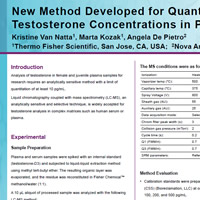
NEW METHOD DEVELOPED FOR QUANTITATIVE ANALYSIS OF LOW TESTOSTERONE CONCENTRATIONS IN PLASMA Kristine Van Natta (1), Marta Kozak (1), Angela De Pietro (2) (1)Thermo Fisher Scientific,San Jose, CA, USA; (2)Nova Analítica São Paulo, SP, BR |
Resumo do Pôster:Analysis of testosterone in female and juvenile plasma samples for research requires an analytically sensitive method with a limit of quantitation of at least 10 pg/mL. Liquid chromatography coupled with mass spectrometry (LC-MS), an analytically sensitive and selective technique, is widely accepted for testosterone analysis in complex matrices such as human serum or plasma. In this study, a LC-MS method was developed and evaluated for the research analysis of low testosterone concentrations in human plasma. The LC-MS system used was a new triple quadrupole mass spectrometer that uses active ion management technology and provides high sensitivity, speed, and dynamic range. Calibration standards were prepared in charcoal stripped serum (CSS) at concentrations in the range from 5 to 500 pg/mL. QC samples were prepared in CSS at 10 and 50 pg/mL. Intra-assay precision was obtained by processing and analyzing a standard curve along with three replicates of each QC sample. Inter-assay precision was obtained by processing and analyzing a standard curve along with three replicates of each QC samples on three different days. Matrix effects were evaluated by comparing peak areas of a 25 pg/mL sample prepared in CSS to a sample prepared in reconstitution solution. Matrix effects in different lots of plasma were evaluated by comparing the internal standard signal in donor plasma samples to the internal standard signal in solvent matrix. The data show the developed method is sensitive and robust, and meets the requirements for testosterone research analysis in human plasma. |
